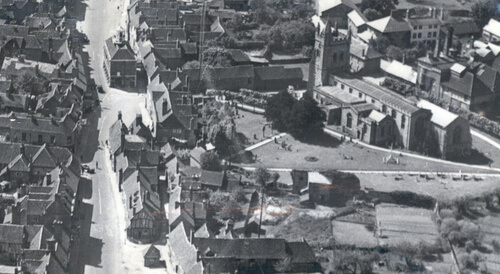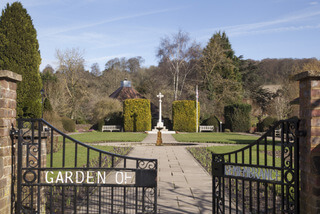
The area to the East of the Market Hall is known as Market Square and until 1939 the fourth side of the square was formed by a double row of cottages down towards The Broadway (see photos below). The local council issued a slum clearance order and these cottages were demolished in 1939.
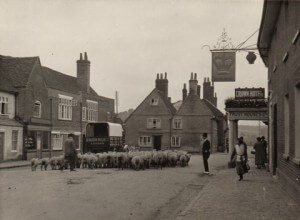
In the two photos above and to the right, looking from the Market Hall, the demolished houses are in the centre of the photo. In the photo above right, looking from The Broadway, the houses demolished are on the right and include Whitesides, the local baker. The aerial photo below was taken before 1939 and shows the Square in front of the Market Hall in the road on the left of the photo.

Listen to Gerald Lee talking in 2004 to Diana Goodbody about the shops which were demolished and the Gas Works and the Bus Garage
Listen to Jean Archer talking in 1991 about the creation of the Memorial Gardens
Memorial Gardens
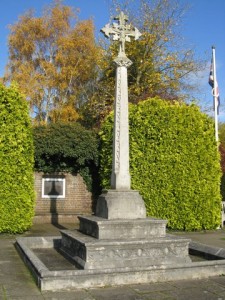
 These gardens were opened in 1949 to commemorate the dead of the two world wars. The WWI memorial, which was previously in the churchyard, is dated unusually 1914-1919, not 1914-1918. Some think this because the Treaty of Versailles was not signed until 1919, although the armistice was at the end of 1918. Others say that soldiers were counted as “war dead” if they died of their wounds after the end of the war. Click here for more information about those who died in WWI.
These gardens were opened in 1949 to commemorate the dead of the two world wars. The WWI memorial, which was previously in the churchyard, is dated unusually 1914-1919, not 1914-1918. Some think this because the Treaty of Versailles was not signed until 1919, although the armistice was at the end of 1918. Others say that soldiers were counted as “war dead” if they died of their wounds after the end of the war. Click here for more information about those who died in WWI.
On a lighter note, Ginger, a cat, lived in these gardens for 16 years. Maggie Pusey from the newsagent’s shop provided food and a box in the shelter. The locals were very fond of Ginger – when he died in 1965, a headstone was made for his grave that you can see under the yew tree next to the wall of the church graveyard.
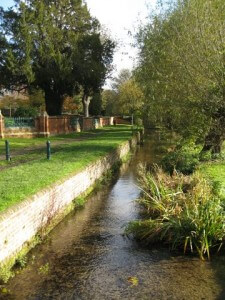 At the North end of the Gardens, there is a gate leading into Church Mead and the River Misbourne. On the other side of the river is the burial ground.
At the North end of the Gardens, there is a gate leading into Church Mead and the River Misbourne. On the other side of the river is the burial ground.  Ruth Ellis, the last woman to be hanged for murder, lies there. Below is an article about the dedication of the burial ground in 1859.
Ruth Ellis, the last woman to be hanged for murder, lies there. Below is an article about the dedication of the burial ground in 1859.
The pedestrian area between the road and the entrances to the Memorial Gardens and the churchyard is also now known as Market Square and was recently enlarged and refurbished. A plaque was erected by Amersham Museum to commemorate the 500th anniversary of the death of the first Amersham martyr. Because the Amersham martyrs were Lollards who wanted to worship in English, not Latin, the plaque commemorates this with the same sentence in both languages.





